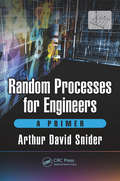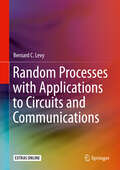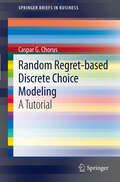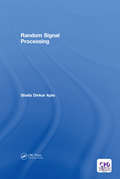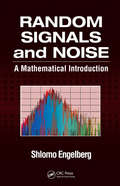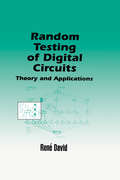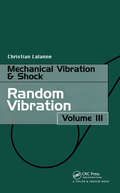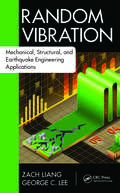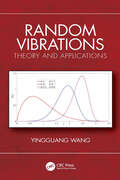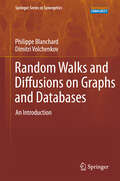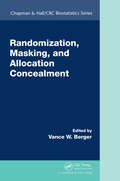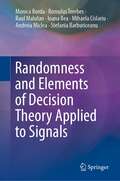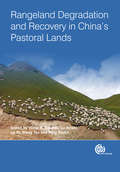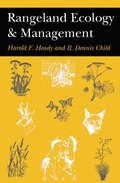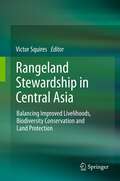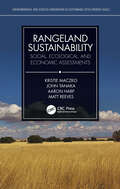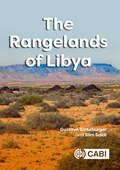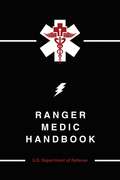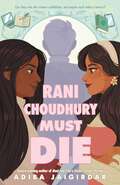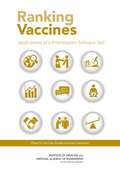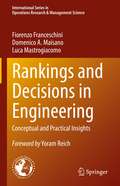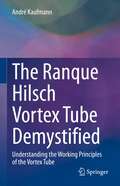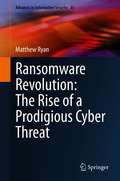- Table View
- List View
Random Processes for Engineers
by Bruce HajekThis engaging introduction to random processes provides students with the critical tools needed to design and evaluate engineering systems that must operate reliably in uncertain environments. A brief review of probability theory and real analysis of deterministic functions sets the stage for understanding random processes, whilst the underlying measure theoretic notions are explained in an intuitive, straightforward style. Students will learn to manage the complexity of randomness through the use of simple classes of random processes, statistical means and correlations, asymptotic analysis, sampling, and effective algorithms. Key topics covered include: - Calculus of random processes in linear systems - Kalman and Wiener filtering - Hidden Markov models for statistical inference - The estimation maximization (EM) algorithm - An introduction to martingales and concentration inequalities. Understanding of the key concepts is reinforced through over 100 worked examples and 300 thoroughly tested homework problems (half of which are solved in detail at the end of the book).
Random Processes for Engineers: A Primer
by Arthur David SniderThis book offers an intuitive approach to random processes and educates the reader on how to interpret and predict their behavior. Premised on the idea that new techniques are best introduced by specific, low-dimensional examples, the mathematical exposition is easier to comprehend and more enjoyable, and it motivates the subsequent generalizations. It distinguishes between the science of extracting statistical information from raw data--e.g., a time series about which nothing is known a priori--and that of analyzing specific statistical models, such as Bernoulli trials, Poisson queues, ARMA, and Markov processes. The former motivates the concepts of statistical spectral analysis (such as the Wiener-Khintchine theory), and the latter applies and interprets them in specific physical contexts. The formidable Kalman filter is introduced in a simple scalar context, where its basic strategy is transparent, and gradually extended to the full-blown iterative matrix form.
Random Processes with Applications to Circuits and Communications
by Bernard C. LevyThis textbook is based on 20 years of teaching a graduate-level course in random processes to a constituency extending beyond signal processing, communications, control, and networking, and including in particular circuits, RF and optics graduate students. In order to accommodate today’s circuits students’ needs to understand noise modeling, while covering classical material on Brownian motion, Poisson processes, and power spectral densities, the author has inserted discussions of thermal noise, shot noise, quantization noise and oscillator phase noise. At the same time, techniques used to analyze modulated communications and radar signals, such as the baseband representation of bandpass random signals, or the computation of power spectral densities of a wide variety of modulated signals, are presented. This book also emphasizes modeling skills, primarily through the inclusion of long problems at the end of each chapter, where starting from a description of the operation of a system, a model is constructed and then analyzed. Provides semester-length coverage of random processes, applicable to the analysis of electrical and computer engineering systems; Designed to be accessible to students with varying backgrounds in undergraduate mathematics and engineering; Includes solved examples throughout the discussion, as well as extensive problem sets at the end of every chapter; Develops and reinforces student’s modeling skills, with inclusion of modeling problems in every chapter; Solutions for instructors included.
Random Regret-based Discrete Choice Modeling: A Tutorial
by Caspar G. ChorusThis tutorial presents a hands-on introduction to a new discrete choice modeling approach based on the behavioral notion of regret-minimization. This so-called Random Regret Minimization-approach (RRM) forms a counterpart of the Random Utility Maximization-approach (RUM) to discrete choice modeling, which has for decades dominated the field of choice modeling and adjacent fields such as transportation, marketing and environmental economics. Being as parsimonious as conventional RUM-models and compatible with popular software packages, the RRM-approach provides an alternative and appealing account of choice behavior. Rather than providing highly technical discussions as usually encountered in scholarly journals, this tutorial aims to allow readers to explore the RRM-approach and its potential and limitations hands-on and based on a detailed discussion of examples. This tutorial is written for students, scholars and practitioners who have a basic background in choice modeling in general and RUM-modeling in particular. It has been taken care of that all concepts and results should be clear to readers that do not have an advanced knowledge of econometrics.
Random Signal Processing
by Shaila Dinkar ApteThis book covers random signals and random processes along with estimation of probability density function, estimation of energy spectral density and power spectral density. The properties of random processes and signal modelling are discussed with basic communication theory estimation and detection. MATLAB simulations are included for each concept with output of the program with case studies and project ideas. The chapters progressively introduce and explain the concepts of random signals and cover multiple applications for signal processing. The book is designed to cater to a wide audience starting from the undergraduates (electronics, electrical, instrumentation, computer, and telecommunication engineering) to the researchers working in the pertinent fields. <P><P> Key Features: <li>Aimed at random signal processing with parametric signal processing-using appropriate segment size. <li>Covers speech, image, medical images, EEG and ECG signal processing. <li> Reviews optimal detection and estimation. <li>Discusses parametric modeling and signal processing in transform domain. <li>Includes MATLAB codes and relevant exercises, case studies and solved examples including multiple choice questions
Random Signals and Noise: A Mathematical Introduction
by Shlomo EngelbergUnderstanding the nature of random signals and noise is critically important for detecting signals and for reducing and minimizing the effects of noise in applications such as communications and control systems. Outlining a variety of techniques and explaining when and how to use them, Random Signals and Noise: A Mathematical Introduction focuses on applications and practical problem solving rather than probability theory.A Firm FoundationBefore launching into the particulars of random signals and noise, the author outlines the elements of probability that are used throughout the book and includes an appendix on the relevant aspects of linear algebra. He offers a careful treatment of Lagrange multipliers and the Fourier transform, as well as the basics of stochastic processes, estimation, matched filtering, the Wiener-Khinchin theorem and its applications, the Schottky and Nyquist formulas, and physical sources of noise.Practical Tools for Modern ProblemsAlong with these traditional topics, the book includes a chapter devoted to spread spectrum techniques. It also demonstrates the use of MATLAB® for solving complicated problems in a short amount of time while still building a sound knowledge of the underlying principles.A self-contained primer for solving real problems, Random Signals and Noise presents a complete set of tools and offers guidance on their effective application.
Random Signals and Processes Primer with MATLAB
by Gordana Jovanovic DolecekThis book provides anyone needing a primer on random signals and processes with a highly accessible introduction to these topics. It assumes a minimal amount of mathematical background and focuses on concepts, related terms and interesting applications to a variety of fields. All of this is motivated by numerous examples implemented with MATLAB, as well as a variety of exercises at the end of each chapter.
Random Testing of Digital Circuits: Theory and Applications
by Rene David"Introduces a theory of random testing in digital circuits for the first time and offers practical guidance for the implementation of random pattern generators, signature analyzers design for random testability, and testing results. Contains several new and unpublished results. "
Random Vibration: Random Vibration (Iste Ser. #Volume 3)
by Christi LalanneThe vast majority of vibrations Encountered in the real Environment are random in nature. Such vibrations are intrinsically complicated, and this volume describes the Enabling process for simplification of the analysis required. and the analysis of the signal in the frequency domain. Power spectrum density is also defined, with the requisite precautions to be taken in its calculation described together with the processes (windowing. overlapping) necessary for improved results. A further complementary method, the analysis of statistical properties of the time signal. is described. This enables the distribution law of the maxima of a random Gaussian signal to be determined and simplifies calculation of fatigue damage to be made by the avoidance of the direct counting of peaks.
Random Vibration: Mechanical, Structural, and Earthquake Engineering Applications (Advances in Earthquake Engineering)
by Zach Liang George C. LeeFocuses on the Basic Methodologies Needed to Handle Random ProcessesAfter determining that most textbooks on random vibrations are mathematically intensive and often too difficult for students to fully digest in a single course, the authors of Random Vibration: Mechanical, Structural, and Earthquake Engineering Applications decided to revise the cu
Random Vibrations: Theory and Applications
by Yingguang WangRandom Vibrations: Theory and Applications investigates methods and theories involved in random vibration analyses of linear and nonlinear systems, as well as in predicting random vibration induced failures.This book is a lucid and well-paced introduction to random vibrations, superbly motivated and illustrated through a wealth of convincing applications in various engineering fields. The strong points of the book are its coverage of weakly stationary and ergodic random processes, spectral analysis of random processes, mode displacement superposition method, equivalent linearization technique for nonlinear random vibrations and an updated definition of rain flow cycle for fatigue analysis. Particularly appealing features of the book are its numerous examples and end-of-chapter exercises. This book offers a clear guide to the formulations and mathematical properties of random vibration analysis techniques, with an emphasis on practical applications rather than mathematical development for its own sake. However, some important mathematical formulas have been explicitly deduced in a detailed manner so that readers can go through the material in this book very smoothly and efficiently.This book is intended for upper undergraduate and graduate students who are interested in learning advanced techniques for performing random vibration analysis, researchers and scientists investigating linear and nonlinear systems under random external excitations, and aeronautical/civil/mechanical/structural/ocean engineers involved in the design and manufacture of real-world stochastically excited engineering systems.
Random Walks and Diffusions on Graphs and Databases
by Philipp Blanchard Dimitri VolchenkovMost networks and databases that humans have to deal with contain large, albeit finite number of units. Their structure, for maintaining functional consistency of the components, is essentially not random and calls for a precise quantitative description of relations between nodes (or data units) and all network components. This book is an introduction, for both graduate students and newcomers to the field, to the theory of graphs and random walks on such graphs. The methods based on random walks and diffusions for exploring the structure of finite connected graphs and databases are reviewed (Markov chain analysis). This provides the necessary basis for consistently discussing a number of applications such diverse as electric resistance networks, estimation of land prices, urban planning, linguistic databases, music, and gene expression regulatory networks.
Randomization, Masking, and Allocation Concealment (Chapman & Hall/CRC Biostatistics Series)
by Vance BergerRandomization, Masking, and Allocation Concealment is indispensable for any trial researcher who wants to use state of the art randomization methods, and also wants to be able to describe these methods correctly. <P><P>Far too often the subtle nuances that distinguish proper randomization from flawed randomization are completely ignored in trial reports that state only that randomization was used, with no additional information. Experience has shown that in many cases, the type of randomization that was used was flawed. It is only a matter of time before medical journals and regulatory agencies come to realize that we can no longer rely on (or publish) flawed trials, and that flawed randomization in and of itself disqualifies a trial from being robust or high quality, even if that trial is of high quality otherwise. <P><P>This book will help to clarify the role randomization plays in ensuring internal validity, and in drawing valid inferences from the data. The various chapters cover a variety of randomization methods, and are not limited to the most common (and most flawed) ones. Readers will come away with a profound understanding of what constitutes a valid randomization procedure, so that they can distinguish the valid from the flawed among not only existing methods but also methods yet to be developed.
Randomness and Elements of Decision Theory Applied to Signals
by Monica Borda Romulus Terebes Raul Malutan Ioana Ilea Mihaela Cislariu Andreia Miclea Stefania BarburiceanuThis book offers an overview on the main modern important topics in random variables, random processes, and decision theory for solving real-world problems. After an introduction to concepts of statistics and signals, the book introduces many essential applications to signal processing like denoising, texture classification, histogram equalization, deep learning, or feature extraction. The book uses MATLAB algorithms to demonstrate the implementation of the theory to real systems. This makes the contents of the book relevant to students and professionals who need a quick introduction but practical introduction how to deal with random signals and processes
Rangeland Degradation and Recovery in China's Pastoral Lands
by Yang Youlin Wang Tao Lu Xinshi Lu Qi Victor R. SquiresThe extreme climate variability that characterizes China's arid rangelands can cause drought and degradation, resulting in dust storms, floods, animal losses, financial hardship and a decline in food availability. Addressing the issues of even greater climate extremes in the future, this book discusses both new approaches and past successes and failures in order to provide the necessary insight to develop sustainable rangeland management strategies, drawing on regional case studies and lessons learned from Australia, Canada and the USA.
Rangeland Ecology And Management
by Harold Heady R. Dennis ChildOver the last two decades the science of range management, like many other resource disciplines, has embraced and integrated environmental concerns in the field, the laboratory, and policy. Rangeland Ecology and Management now brings this integrated approach to the classroom in a thoroughly researched, comprehensive, and readable text. The authors discuss the basics of rangeland management--including grazing and practical management of animals and vegetation--and place those basics within the context of decision making for damaged land, riparian and water conservation, multiple use, and modeling. Concepts such as succession, stability, and range condition are examined and their effects discussed. Fire is considered as an environmental factor. Appendixes provide scientific and common names of range plants and animals. These and many other issues crucial to the understanding of successful range management combine to make the finest text for upper-level undergraduates now available.
Rangeland Stewardship in Central Asia
by Victor R. SquiresThis volume of 18 chapters is the work of more than 30 authors, many of whom are natives of the Central Asian region or are researchers who have dedicated a large part of their working lives to studying the development dynamics in this vast and fascinating region. The work focuses on the 20 years since the collapse of the Soviet Union in 1990. But it also traces the attitudes of land users to the land dating from before the late 19th century, when Russian conquest and colonization occurred, and through the upheavals caused by Soviet-style collectivization and sedentarization. The book is rich with new data presented in 68 easy to understand charts/graphs (many in color) and 50 Tables. Information was generated for this book by experts working in-country. It presents for the first time in English a digest of plethora of previously inaccessible Russian reports and scientific literature that will be invaluable for development agencies, including UN, World Bank, Asian Development Bank, Islamic Bank as well as to students of this vast and fascinating region who seek up to date and authoritive information.
Rangeland Sustainability: Social, Ecological, and Economic Assessments (Environmental and Societal Dimensions of Sustainable Development Goals)
by Kristie Maczko Aaron Harp John Tanaka Matt ReevesThis book provides an integrated description of the indicators of rangeland sustainability that capture ecological, economic, and social dimensions. It takes a fresh look at the information available on current and emerging issues across rangelands, and presents collaborative research for future progress. Authors offer a framework for evaluating rangeland sustainability, the best available data to use, as well as an interactive tool for use at a variety of geographical scales. Readers with limited knowledge of rangelands, as well as professional rangeland ecologists and land managers, will gain an understanding of the best tools available today to assess sustainability across rangeland ecosystems in the U.S.
The Rangelands of Libya
by Gustave Gintzburger Slim SaïdiLibya remains a land of mysteries with a harsh arid climate, a land rich in millenaries of troubled history, a land where the Sahara meet the Mediterranean Sea, a land where the West and the East Mediterranean merge. Libya is also a land where the desert and the sown intermingle in the steppe country where the rainfall is unpredictable, the soils are poor, rocky, saline, rendering rainfed cultivation hazardous, where grazing and rainfed cropping remained for long the only viable agricultural options. Over the past 60 years, oil resources allowed gigantic agricultural development projects, urbanization, road network expansion and well drilling. This changed the ways of life of rural populations, impacting and undoubtedly altering rangelands conditions and systems, as well as native vegetation cover, wildlife and land use. This book reviews the past and current environmental and agricultural condition of the Libyan rangelands with example of how territories and resources are used by tribal communities. It describes, explains and illustrates the landscapes, the vegetation, the wildlife, the rainfed cereal systems and livestock systems, the reasons for the rampant overstocking, the relentless land clearing for hazardous cropping and uncertain irrigation projects, the wild fuelwood collection and charcoal manufacturing, triggering land degradation and desertification. Long-tested rangeland recovery and rehabilitation techniques in Libya are reviewed using appropriate plant material and proven establishment techniques with successes and failures assessed. This book is offered in hopes of a better future for the Libyan people and the whole Mediterranean arid regions from Morocco to Pakistan.
Ranger Medic Handbook
by U.S. Department of DefenseHistorically in warfare, the majority of all combat deaths have occurred prior to a casualty ever receiving advanced trauma management. The execution of the Ranger mission profile in the Global War on Terrorism and our legacy tasks undoubtedly will increase the number of lethal wounds. Ranger leaders can significantly reduce the number of Rangers who die of wounds sustained in combat by simply targeting optimal medical capability in close proximity to the point of wounding. Directing casualty response management and evacuation is a Ranger leader task; ensuring technical medical competence is a Ranger Medic task. A solid foundation has been built for Ranger leaders and medics to be successful in managing casualties in a combat environment. The true success of the Ranger Medical Team will be defined by its ability to complete the mission and greatly reduce preventable combat death. Rangers value honor and reputation more than their lives, and as such will attempt to lay down their own lives in defense of their comrades. The Ranger Medic will do no less.
Rani Choudhury Must Die
by Adiba JaigirdarIn this sapphic dual POV romance by Adiba Jaigirdar, Meghna and Rani (ex-best-friends-turned-rivals) realize they're dating the same guy, so they team up to beat and expose him at a big science competition! Meghna Rahman is tired of constantly being compared to her infuriatingly perfect ex best friend now rival. Everyone, except, at least, her boyfriend Zak, seems to think that Rani Choudhury can do no wrong—even her own parents! It doesn’t help that Rani is always accepted into the Young Scientist Exhibition, while Meghna’s projects never make it. But this year, she finally has a chance at defeating Rani in something.Rani Choudhury is tired of feeling like she doesn’t have much say in her life—not when it comes to how her mom wants her to look and act or how her parents encourage her to date incredibly charming close family friend Zak. She would much rather focus on her coding, especially once she places high enough at the Young Scientist Exhibition to go on to the European Young Scientist ExhibitionWhen Meghna and Rani figure out that Zak has been playing them both, they decide to do something no one would see coming: they team up. They’ll compete in the EYSE as partners, creating an app that exposes cheaters and a project that exposes Zak. But with years of silence and pressure between them, working together will prove difficult. Especially once each girl starts to realize that the feelings they had for the other may have been more than platonic...Hey, no one ever said science was easy!
Ranking Vaccines: Use Case Studies and Data Framework
by Guruprasad MadhavanSMART Vaccines - Strategic Multi-Attribute Ranking Tool for Vaccines - is a prioritization software tool developed by the Institute of Medicine that utilizes decision science and modeling to help inform choices among candidates for new vaccine development. A blueprint for this computer-based guide was presented in the 2012 report "Ranking Vaccines: A Prioritization Framework: Phase I. " The 2013 "Phase II" report refined a beta version of the model developed in the Phase I report. "Ranking Vaccines: Applications of a Prioritization Software Tool: Phase III: Use Case Studies and Data Framework" extends this project by demonstrating the practical applications of SMART Vaccines through use case scenarios in partnership with the Public Health Agency of Canada, New York State Department of Health, and the Serum Institute of India. This report also explores a novel application of SMART Vaccines in determining new vaccine product profiles, and offers practical strategies for data synthesis and estimation to encourage the broader use of the software.
Rankings and Decisions in Engineering: Conceptual and Practical Insights (International Series in Operations Research & Management Science #319)
by Fiorenzo Franceschini Luca Mastrogiacomo Domenico A. MaisanoThis book focuses on decision-making problems in engineering. It investigates the ranking aggregation problem and the related features, such as input/output data, simplification hypotheses, importance hierarchy of experts. In addition to a well-structured overview of several interesting, consolidated methodological approaches, it presents innovative approaches that can also be applied profitably in other fields. The fascinating selection of topics included is based on research that has been developed in the past twenty years. The descriptions are supported by figures, tables, flowcharts, diagrams, examples and practical case studies. The book is an ideal resource for engineering academics, practitioners, technicians and students, who do not necessarily have an in-depth knowledge of decision-making. It is also a thought-provoking read for engineers and academics looking for innovative ways to improve engineering processes in a variety of fields, such as conceptual design, quality improvement, reliability engineering. “Today, rankings are exercised in all spheres of life, products are ranked on Amazon and similar platforms; services such as restaurants and hotels on platforms such as TripAdvisor; and other services such as lectures or even medical treatment on different specialized platforms. We often make our daily decisions based on these rankings. The quality of our decisions depends on our ability to select appropriate methods to fit the context and needs. We need to be familiar with the theory and practice of these methods to make them useful. To this purpose, this book is an important addition to the bookshelves of academics and professionals, not only from engineering. The connection between theory and practice is weaved throughout the book, making it useful for practitioners also.” Prof. Yoram Reich, Full Professor and Head of Systems Engineering research Initiative at Tel Aviv University (Israel), Editor-in-Chief of “Research in Engineering Design”
The Ranque Hilsch Vortex Tube Demystified: Understanding the Working Principles of the Vortex Tube
by André KaufmannThe book describes the thermodynamics, fluid dynamics, and working principle of the Ranque Hilsch Vortex Tube. Although vortex tubes have been around for a long time, different explications of their fundamental physics and operation can be found in literature and on the internet. This volume investigates the working principle based on thermodynamics and fluid dynamics. It provides full explication of these parameters in one single work along with results of new investigations not published elsewhere. In addition, the book features a wealth of illustrations on various aspects of the vortex tube that make it easy to read and understand.
Ransomware Revolution: The Rise of a Prodigious Cyber Threat (Advances in Information Security #85)
by Matthew RyanThis book explores the genesis of ransomware and how the parallel emergence of encryption technologies has elevated ransomware to become the most prodigious cyber threat that enterprises are confronting. It also investigates the driving forces behind what has been dubbed the ‘ransomware revolution’ after a series of major attacks beginning in 2013, and how the advent of cryptocurrencies provided the catalyst for the development and increased profitability of ransomware, sparking a phenomenal rise in the number and complexity of ransomware attacks. This book analyzes why the speed of technology adoption has been a fundamental factor in the continued success of financially motivated cybercrime, and how the ease of public access to advanced encryption techniques has allowed malicious actors to continue to operate with increased anonymity across the internet. This anonymity has enabled increased collaboration between attackers, which has aided the development of new ransomware attacks, and led to an increasing level of technical complexity in ransomware attacks. This book highlights that the continuous expansion and early adoption of emerging technologies may be beyond the capacity of conventional risk managers and risk management frameworks.Researchers and advanced level students studying or working in computer science, business or criminology will find this book useful as a reference or secondary text. Professionals working in cybersecurity, cryptography, information technology, financial crime (and other related topics) will also welcome this book as a reference.

